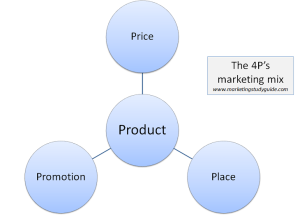Overview of the 4P’s Marketing Mix
A key model in marketing is the marketing mix, usually known as the 4P’s (where the 4P’s are product, price, place and promotion). The 4P’s marketing mix model is commonly covered in all marketing textbooks, with some introductory texts also addressing the expanded marketing mix (the 7P’s), which is more appropriate for a marketing a service (an intangible offering). In some textbooks, two of the 4P’s (namely product and price) are known as the “product offer”.

Click to enlarge model
The marketing mix concept was initially developed by Neil Borden from Harvard University in the 1960’s. Essentially, his goal at the time was to categorize the main tasks that were undertaken by people in marketing roles. His initial list contained 12 main elements. Over time, various academic researchers further defined and reviewed this work and finally the simplified 4P’s marketing mix structure was adopted.
While the marketing mix is a simplification of what a marketer does in a real organization, it is a nice, simple overview of the scope of marketing and is ideal for students new to marketing principles. It clearly demonstrates that from a textbook perspective, that marketing extends beyond its traditional promotion/advertising background to encompass key product, pricing and distribution channel (place) decisions.
Individually, each marketing mix element is a tactical decision for an organization. For example, if the firm decides to use discount pricing, then they are using a price tactic. However, when all the marketing mix elements are aligned and integrated together, collectively they form the firm’s marketing strategy.
Using the same price discounting example; if the firm were targeting budget-conscious consumers and also had a simple range of lower quality products, distributed through discount stores and/or online (place) and used promotion to communicate that they offer great value – then the 4P’s marketing mix elements are being used collectively to implement the firm’s overall strategy.
Each of the four marketing mix elements consists of many options and potential configurations. For example, a large firm may produce and sell 1,000’s of different products, distributed across numerous channels, with a range of pricing tactics used, and supported by a variety of different communications. Therefore, while the marketing mix is conceptually quite easy to understand; its real life structure and implementation is usually quite challenging.
